Galleries
With Outposts in Mexico City and New York, the Influential Gallery Kurimanzutto Celebrates 25 Years
The husband and wife duo José Kuri and Mónica Manzutto didn't intend to change the world. But their guerrilla pop-ups spread the gospel of Mexican art and led to outposts in CDMX and New York as well as a new world order.
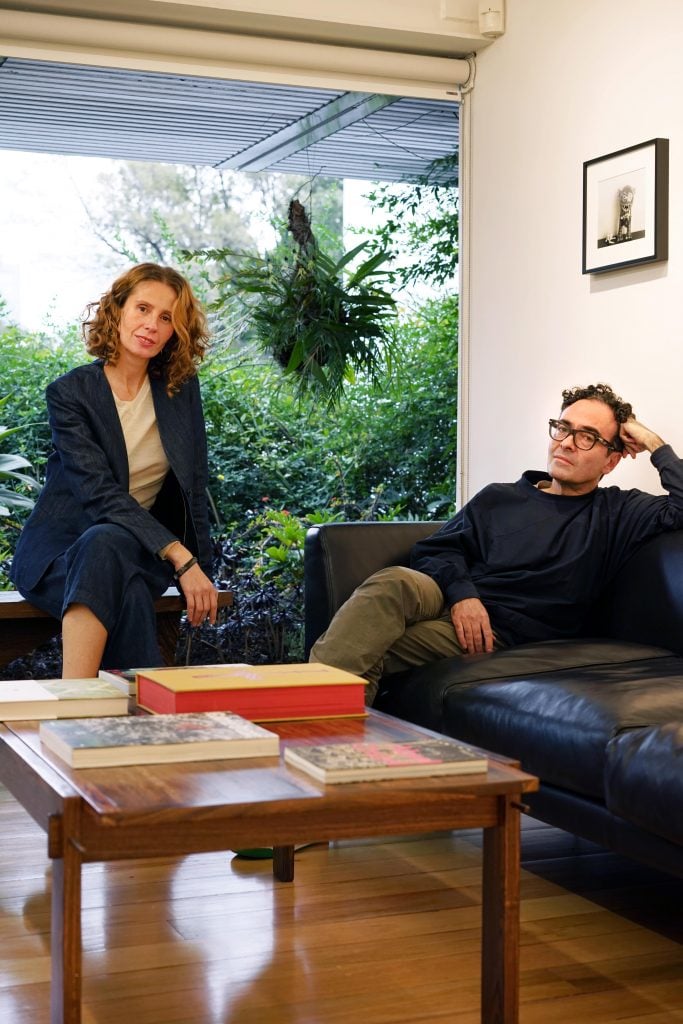
Kurimanzutto is celebrating its 25th anniversary this year. Founded by its namesake husband-and-wife duo, José Kuri and Mónica Manzutto, the influential gallery played a fundamental role in introducing the international art world to contemporary Mexican art.
Today, kurimanzutto is known for its omnivorous tastes and broad reach, promoting homegrown Mexican talent veering from contemporary art heavyweight Gabriel Orozco to anti-fashion androgyne Bárbara Sánchez-Kane. They also represent international artists and estates, and recently announced they are handling the John Giorno estate, hosting a solo show of his work, “Jasmine Burn,” next month at their New York outpost.
It’s been a long journey to this height of success. Though the gallery was technically founded in 1999, the origins of the gallery were planted decades before.
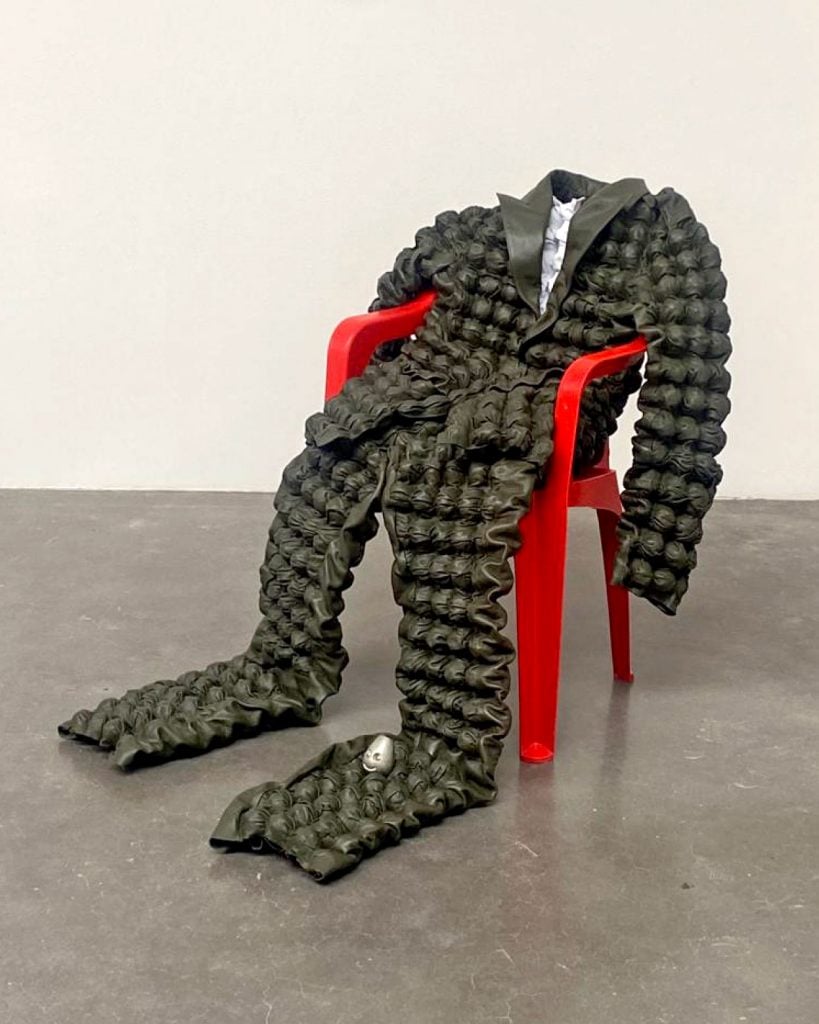
Bárbara Sánchez-Kane, untitled (2023). Military gear in green lambskin leather. Courtesy of Kurimanzutto Gallery.
“Ok, I’ll start from before the beginning,” Kuri said earlier this month, from his office in the West Chelsea gallery, a highlighter-yellow sneaker propped on his knee. “I wear these everywhere,” he added as an aside, “weddings, work—I hate to have to make decisions.” He exuded a humble, calm affect that belied his enormous energy.
His other half, Manzutto, was wrapping up the loose ends left over from the sprint that was CDMX Art Week in Mexico City. Alongside an Orozco exhibition at their main gallery there, they had a booth at the Zona Maco fair, presentations at the satellite events Material and Salon Acme, and five institutional exhibitions that included their artists, including at the Museo Tamayo, the Museo Jumex, and the Museo Nacional de Antropologia.
Kuri continued his art world origin story, saying it all started when he was about 11, and his aunt got remarried. Her new husband was a “crazy, hippie architect” with two sons and a home in the bohemian neighborhood of Coyoacán. This was quite different from Kuri’s own home life, which he described as conventional and middle-class (both of his parents were dentists, though his mother would later become a science historian).
One day, during a visit to his aunt’s, he found a stranger, a young man with his head bowed, scrawling in a sketchbook with his left hand. “I was shocked by this beautiful image,” Kuri recalled. “The sun was coming in, there was a big window. He had long hair—something I couldn’t have at that time, long, curly hair—and was drawing. His face comes up. I asked him, ‘Who are you?’ He said, ‘I’m an artist, Gabriel.’”
Gabriel Orozco, was 18 years old and had left his family’s home to live with Kuri’s new cousins. Kuri was impressed that someone so young felt confident enough to call themselves an artist. The pair began a lifelong friendship, which would grow to include Manzutto and have an outsized effect on Mexican contemporary art.
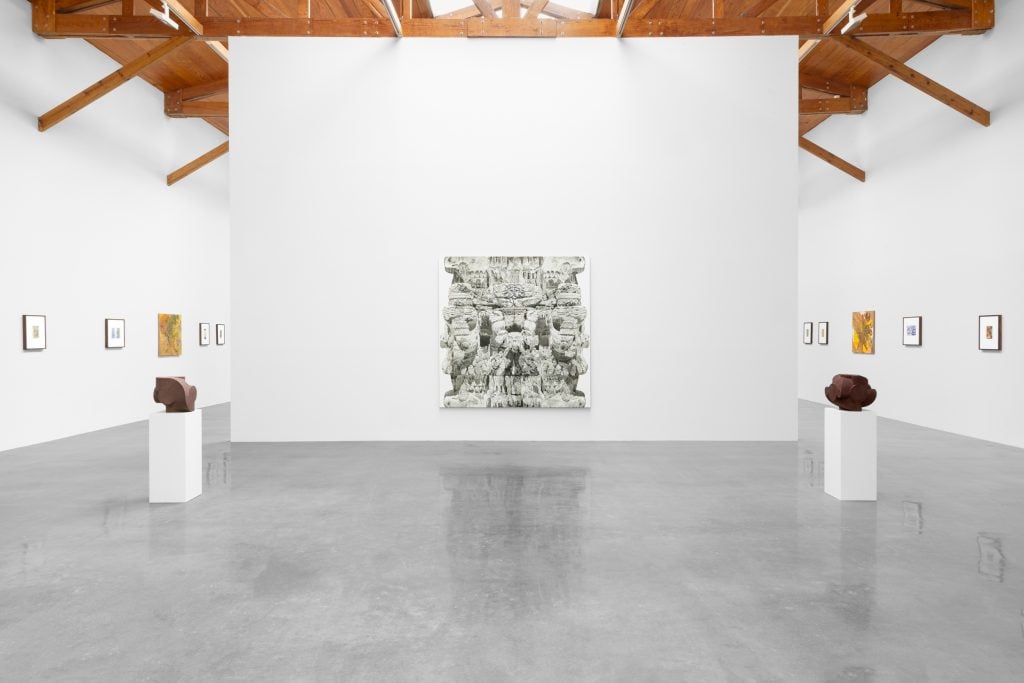
Installation views of “Gabriel Orozco: Diarios de Plantas” at kurimanzutto, Mexico City, 2024. Photo: Gerardo Landa / Eduardo López (GLR Estudio), 2024.
It wouldn’t be going too far to make a comparison to the likes of Paul Durand-Ruel or Peggy Guggenheim, visionaries who respectively helped bring Impressionism and Abstract Expressionism into the world as dealers and patrons. Whereas we might understand Durand-Ruel’s impact as the result of an exceptional eye and keen business acumen, the story of kurimanzutto is defined by a sense of collectivity that breathes through the gallery’s history.
“We are such a constellation of the people that we depend on,” Manzutto said. “What we are capable of as a gallery is bringing together these artists, who are so interdisciplinary, intergenerational, who bring so many different ways of doing and thinking and who shape what we do and what will come.”
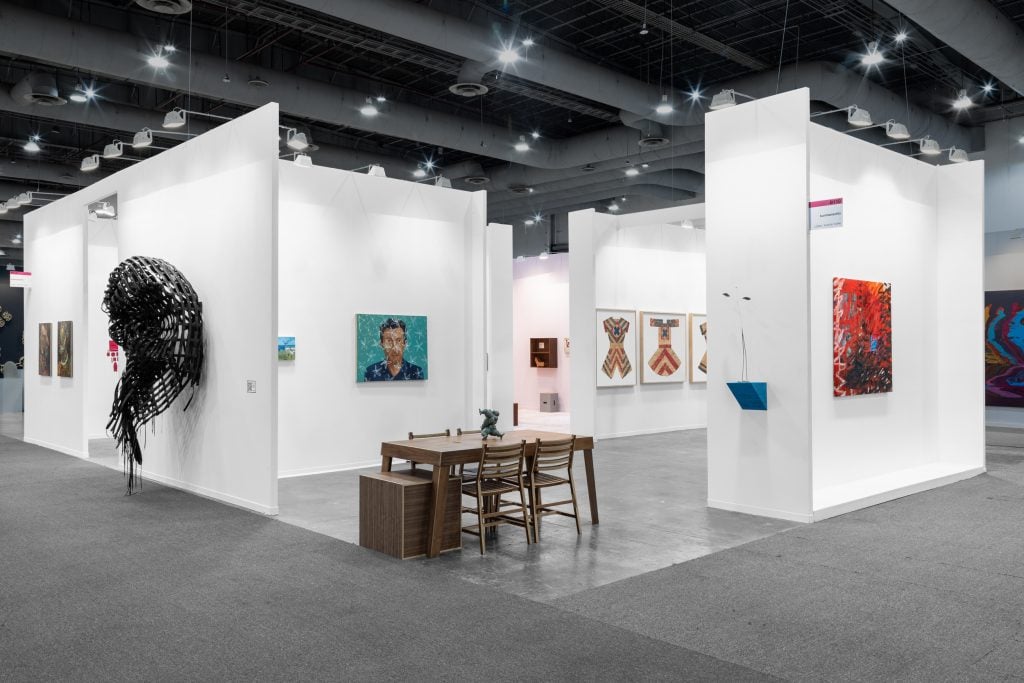
Installation shot of the kurimanzutto’s booth at the Zona Maco art fair, 2024. Photos: Gerardo Landa Rojano / Eduardo López (GLR studio).
Like Kuri and Orozco, the first artists kurimanzutto represented had met each other in their youth. In fact, Orozco had gathered them.
It was 1986. Mexico City was still recovering from a major earthquake the year before, and the country was hosting the World Cup while suffering through a recession. Orozco had just arrived after years spent in Madrid studying at the Círculo de Bellas Artes. Kuri had entered university at the Instituto Tecnológico Autónomo de México (ITAM) to study economics, but another kind of education was to come into his life: Orozco’s famous Taller de los viernes, or, “Friday Workshops.”
Orozco had brought together Damián Ortega, Abraham Cruzvillegas, Gabriel Kuri (José’s brother) and Dr. Lakra to transmit what he had learned about art and the art market while in Spain. Orozco had taken it upon himself to act as a mentor for this young generation of upstart artists. And they were young. At the time, Gabriel Kuri was finishing high school and Dr. Lakra was just 16. Orozco still refers to this group of artists as the “muchachos,” or the boys.
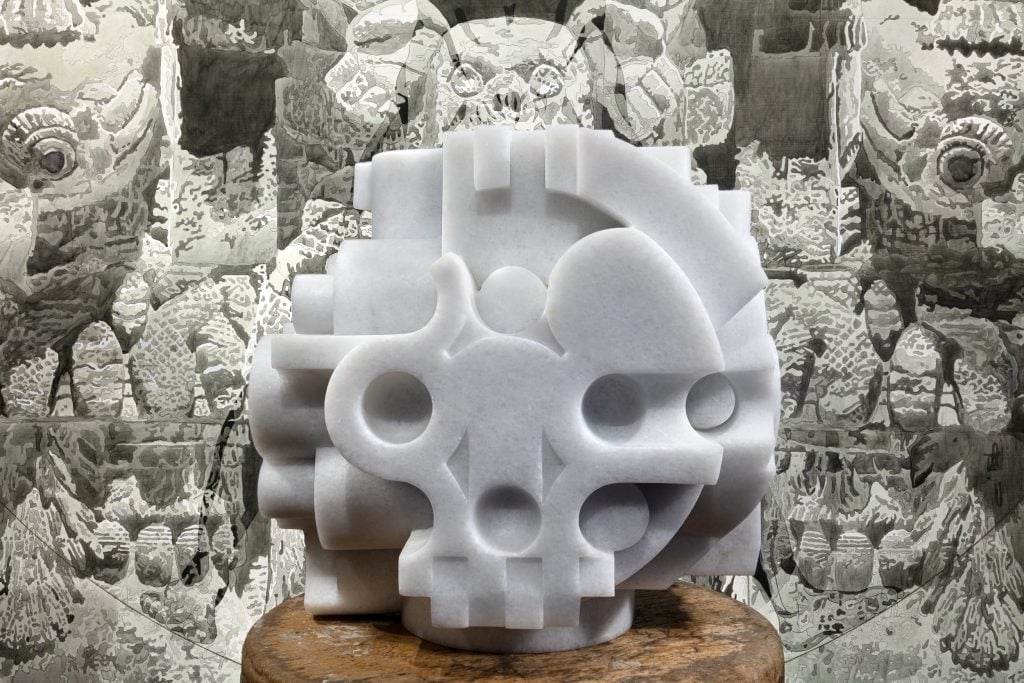
Gabriel Orozco, Untitled (2021–24), marble. Photo: courtesy of the artist and kurimanzutto, Mexico City / New York photo by Gerardo Landa / Eduardo Lópex (GLR estudio).
“Information didn’t circulate the way it does now,” Kuri said. He tagged along to the workshops with his brother for the five years that it lasted. “Gabriel [Orozco] would bring a book and we would all share, one person would have it two days and then the next person would take it. Everything was word of mouth.”
Kuri’s artistic education continued as he helped with his friend’s exhibitions, driving the van, making deliveries, installing works. Yet, “it never crossed my mind that art could be a job,” he recalled. “It was impossible to make a living out of art, or at least I thought it was impossible.”
Soon after Kuri finished university, he was set up on a blind date. He was 23, she was 19. Mónica Manzutto was working as a model and hoping to become a translator. Manzutto’s biological father was Italian and had passed away when Manzutto was a small child. She had been about to move to Italy to pursue further language studies when she met Kuri.
“He was wearing a yellow coat and all his clothes were second hand,” Manzutto said. “I met him and that was it. I quit everything and canceled my trip to stay in Mexico.”
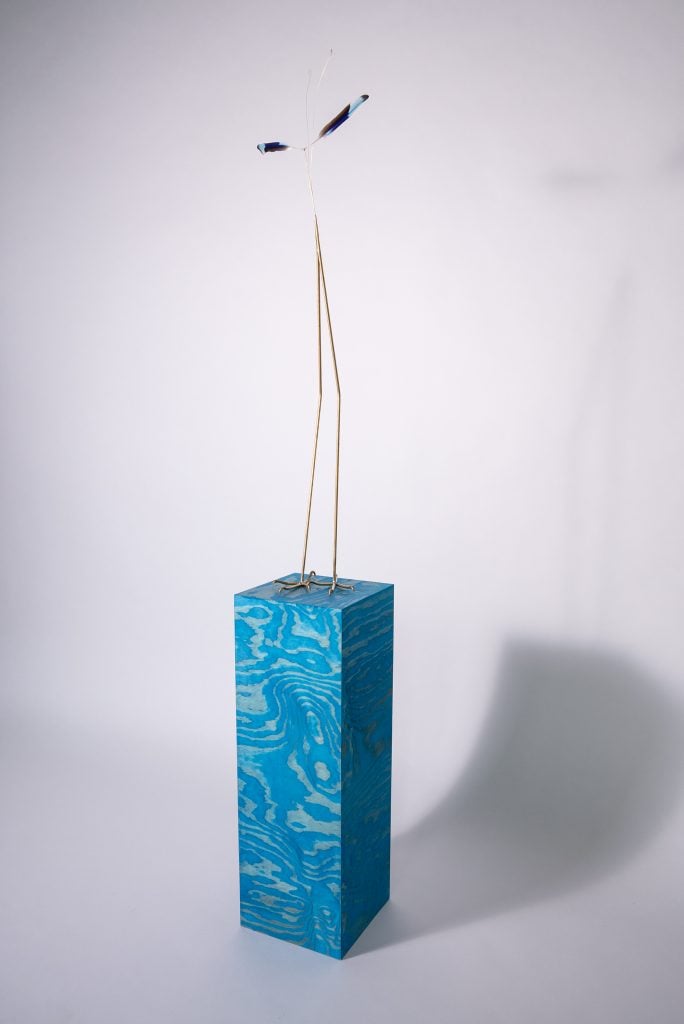
Petrit Halilaj, Here To Remind You (Coracias benghalensis) (2023). Photo: courtesy of kurimanzutto.
They have been together ever since, despite the fact that they are, apparently, complete opposites. Kuri listed her attributes, counting off on his fingers: “She’s so practical, so hands on, solves every problem. Me, I’m a complete lunatic, I waste time, I don’t answer emails. I don’t know what I would do without her.”
In 1997, the couple moved to New York together to pursue master’s degrees. Kuri was studying economics at Columbia and Manzutto was at NYU doing cultural studies, though she eventually left the program.
Orozco had arrived in the city in 1992 and set up his base camp. In 1993 he had his first show at MoMa and participated in the Venice Biennale. An intense travel period followed (and a rising profile as an artist). In 1995 alone he had exhibited in Milan, LA, Moscow, Zurich, Boston, Vienna, Rotterdam, London, Madrid, Grenoble, and Bretagne. By 1996 his works were on view at MoMA and by 1998 he had been in four biennales.

Gabriel Orozco, Untitled (2021–22). Photo: courtesy of the artist and kurimanzutto, Mexico City / New York photo by Gerardo Landa / Eduardo Lópex (GLR estudio).
Though this kind of globe-hopping is now expected of any uber-successful artist, in the 1990s, Orozco’s international reach was unique, and he was often referred to as a nomad. It’s a label he shook off impatiently during our interview in Mexico City at the beginning of CDMX Art Week, just hours before the opening of his show “Diarios de Plantas” at kurimanzutto.
The show is a quintessential display of Orozco’s prolific nature: selections from a sketchbook in which he documented the leaves that fell at his feet during his travels; a series of sculptures that have grown out of his collaboration with Indonesian limestone carvers; and a new suite of paintings that honor two iconic figures, Leonardo Da Vinci’s Vitruvian Man and Coatlicue, the Aztec goddess of life and death.
“I became known as a nomadic artist just because I was not obsessed with making it and being super rich and famous in New York. I wanted to dislocate this self-obsession the city had with itself,” Orozco said, leaning back on the black couch in the gallery’s upstairs office, a garden of towering succulents darkening in the background as twilight took hold.
Orozco has a leonine presence with thick white hair, long enough to curl under his ears. He exudes a steady, burning self confidence that Kuri said Orozco has always possessed. At this point in his career, the world quietly revolves around him.
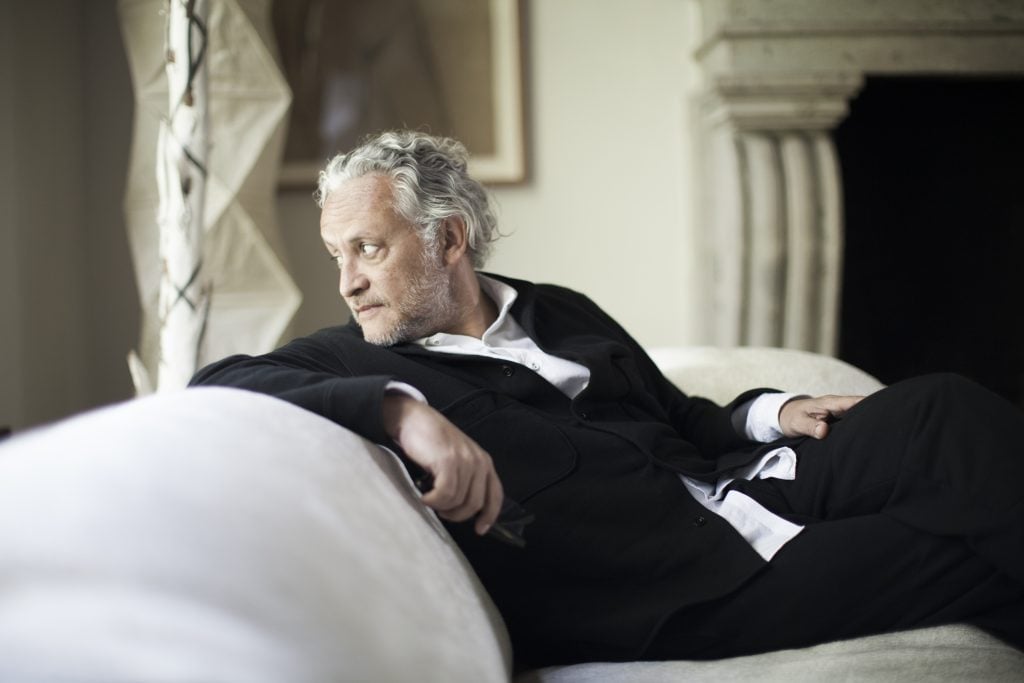
Artist Gabriel Orozco by Ana Hop. Courtesy of kurimanzutto
When he was sitting with the Mexican press during opening day of “Diarios de Plantas,” he lit a cigarette with a silver lighter engraved with two crossed pistols and slung his arm over the back of his chair, the smoke wafting up his jacket sleeve. When he stubbed his cigarette out on the ashtray in front of him, his assistant made a silent gesture to someone across the room, and a new ashtray was placed in front of him.
This is the kind of management of one’s person that comes with the expectation of constant movement and performance. Orozco is now ensconced in a major public project after Mexican President Andrés Manuel López Obrador invited him to design a new Master Plan for a 250-acre section of the Bosque de Chapultepec, Mexico City’s largest park.
While he hadn’t quite reached this height in 1998, his career was moving at an explosive pace. MOCA LA had reached out about doing a retrospective that would then travel to Monterrey and Mexico City. It was at this time that Orozco realized that he didn’t have the infrastructure in Mexico to help with a project of this stature.
Meanwhile, the artists he had left behind had continued on without him, growing and exhibiting without any gallery representation. He thought someone should do something about that. Orozco convinced Kuri to spend his last year at Columbia studying the business of art and he got Manzutto an internship at his New York gallery, Marian Goodman.
The way Kuri and Manzutto tell it, they don’t recall any serious discussions of whether or not they should pursue this future, but speak of the decision to pursue the gallery as one that was made unconsciously, instinctively. All they needed was a bit more time.
“You know how it is in New York,” Orozco said, blowing out smoke. “One year, or six lucky months in that city, you can learn a lot of things.”
There was perhaps no better place for Manzutto to learn the art trade than at Marian Goodman, a gallery known for introducing European artists to American audiences and its artist-centered approach. She worked there for a year and a half, mainly in the archive department under Elaine Budin, who became not just a mentor but something of a second mother. One of Manzutto’s first tasks was putting the archives of the German photographer Thomas Struth into order.
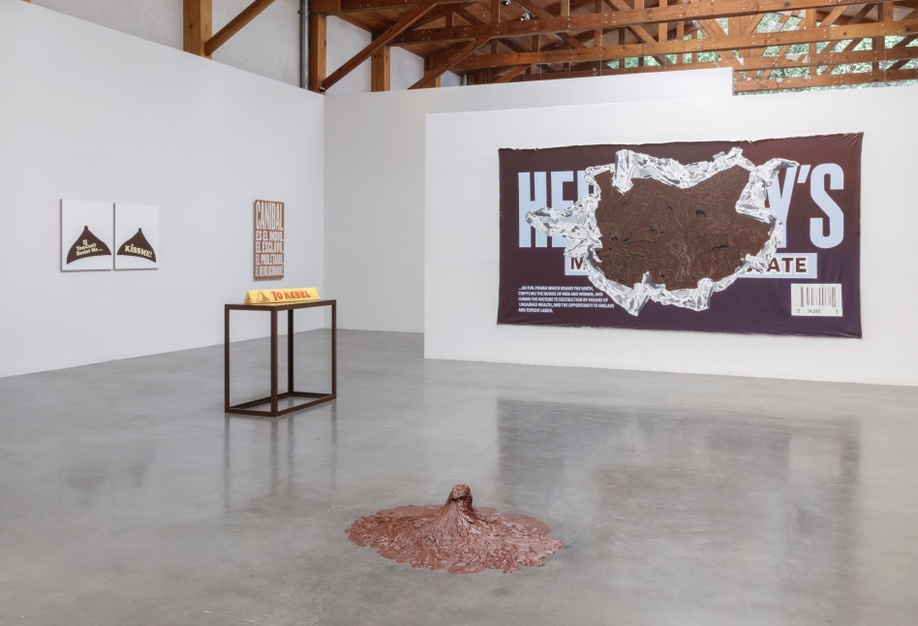
Minerva Cuevas, Feast and Famine (2015), mixed media installation. Photo: courtesy of the artist and kurimanzutto, Mexico and New York.
“It was amazing because it was really like a deep dive into understanding what Marian had tried to do with bringing this whole generation of European artists to the US,” Manzutto said. She admired Goodman for her commitment to the artists that she worked with, ensuring that she was not just finding them collectors but building their legacies. Yet, the art world was also a fundamentally different place in the late 1990s.
“Art was not an industry back then. And that was kind of precious. The pace was much slower. We would send Ektachrome slides in the mail for a client to see a piece,” said Manzutto. “The museums were dictating most of what was happening. We believed that this was where we could create knowledge.” This power balance began to change as galleries expanded, international fairs became the norm, and new technologies allowed trade to occur at a rapid clip.
It was within this shift and the rise of the internet that kurimanzutto was founded, poised to play its part in an evolving, global art market. Kuri graduated in June of 1999, the couple moved back to Mexico City, and the gallery had its first show by August.
There were no family investments or friendly backers, but that was okay because they only had two expenses: the telephone landline they had set up for the gallery, which they ran out of their apartment, and a Mac desktop computer that was paid for with a scholarship Kuri had won to offset the last $5,000 of his student debt, which he doesn’t think ever got paid off. He and Manzutto lived with Kuri’s parents for a few months to save money.
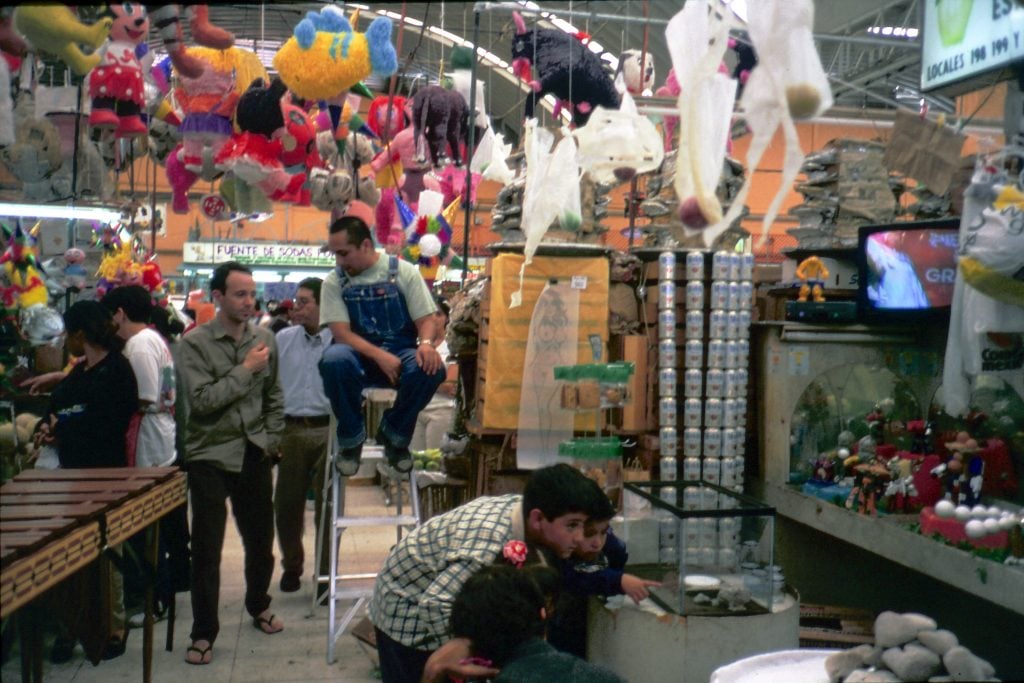
Installation view of “Economía de mercado (Market Economy)” kurimanzutto’s very first group show in 1999, presented as a pop-up in Medellín market. Photo: courtesy of kurimanzutto.
“Those were some of the happiest days of my life, I was just with my friends thinking about how we would do the gallery, how would we survive,” Kuri said. “Our main focus at that time was ‘We need to resolve their lives so they can only be artists, so they don’t waste their time doing two or three jobs.’”
Kurimanzutto’s first show, “Economía de mercado” (Market Economy)” opened on August 21, 1999 in the Medellín market among the fruit stands and comals with works by 14 artists, including Orozco, Rirkrit Tiravanija, Daniel Guzmán, Minerva Cuevas, and Abraham Cruzvillegas. The works they showed were made using materials from the market—beer cans, embroidery hoops, oranges—and as such were priced accordingly, with works sold for 25 to 500 pesos.
The show, open for just 24 hours, was a success. With this bold gesture, Kuri, Manzutto, and the artists displayed their commitment to a distinctly Mexican contemporary art making, literally taking the materials of their environment to bring this new wave to the fore. Even as the gallery hustled to make ends meet, they continued to take risks, to stage shows in places like parking lots, shipping containers, restaurants, and whatever other spaces they could commandeer for cheap to nothing.
“In New York, there’s a very robust market but it’s a tight one. There is very little space for experimentation. You have to come and deliver and you have very little space for doing something wrong,” Kuri said. “In Mexico, there was no art market. So we were completely free. Everyone was complaining that there was no market but it was also amazing in terms of artistic development.”
Looking down the barrel of 25 years since that moment, it’s hard not to see the gallery’s growth as simply fated. But in those first years, nothing could be taken for granted. And mixing business, marriage, and friendship had its own learning curve.
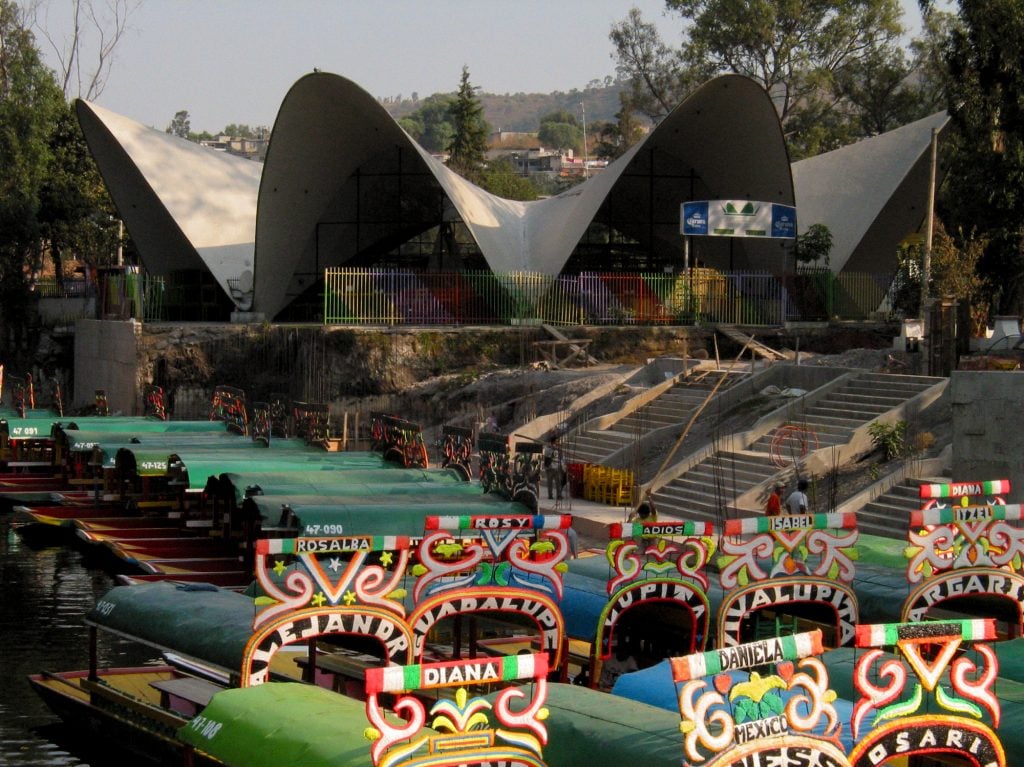
“Elephant Juice (Sexo entre amigos)”, a one-day group organized in Los Manantiales restuarant, in Xochimilco, Mexico City, in 2003. Photo: courtesy of kurimanzutto.
“We didn’t really know what it meant, having a gallery, working with artists who were also your best friends. And José and I are very different people, the way we do things, the way we think through things,” Zutto said. “But it’s become a great partnership. We complement each other in a way that gives the artist a lot of options and that gives us a lot of options as a family.” The couple have two children together, a boy and a girl.
Kuri and Manzutto watched as the Mexican and international art scene mutated into what it is today. At home, the couple began an important relationship with Eugenio López, the heir to the Grupo Jumex fruit juice fortune and a champion of Mexican contemporary art. In 2001, Lopez founded the Fundación Jumex Arte Contemporáneo, which included a great number of works sourced from kurimanzutto. Then, in 2004, Zona Maco, Mexico’s first contemporary art fair, was founded. Things were also shifting at the international level.
In the 2000s, American and European institutions had an increasing interest in exhibiting works from the rest of the world. Kurimanzutto’s Mexican artists were, of course, the chosen emissaries of contemporary Mexican art and were included in shows like PS1’s “Mexico City: An Exhibition about the Exchange Rates of Bodies and Values” (2002); ICA Boston’s “Made in Mexico” (2004), and the MCA Chicago’s “Escultura Social: A New Generation of Art from Mexico City” (2007).
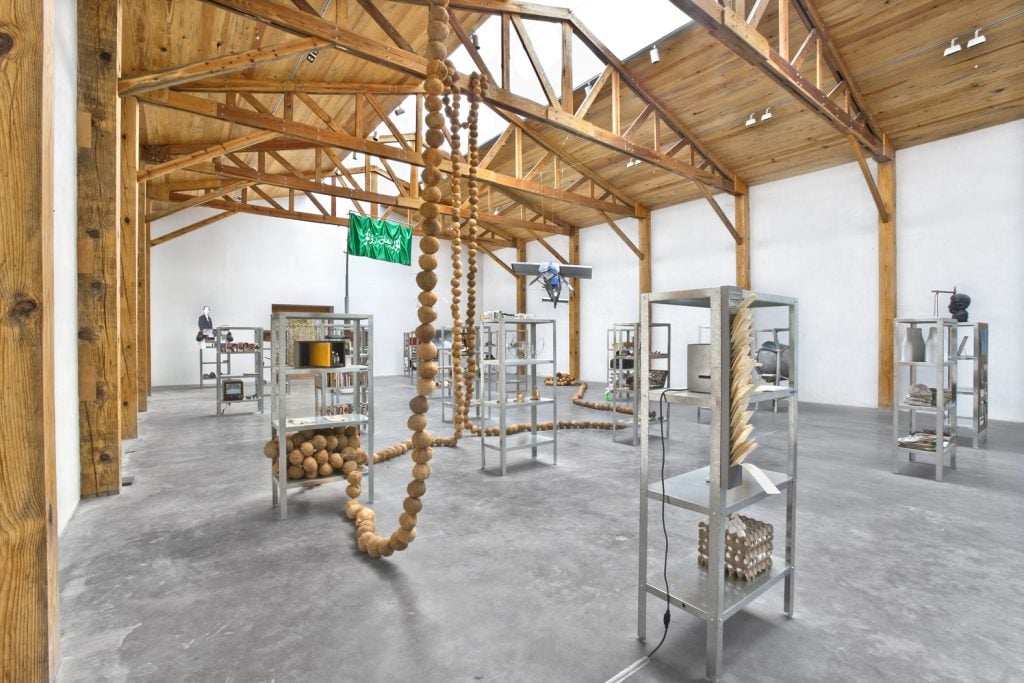
Installation view of kurimanzutto’s gallery space in Mexico City, 2008. Photo: courtesy of kurimanzutto.
During this period, Kuri was beset with a drawn-out anxiety: “I kept thinking, If only we can overcome the trend of ‘art from Mexico.’” To avoid this, Kuri and Manzutto would close the gallery three months straight to travel internationally with the explicit purpose of making and sustaining relationships with major institutions around the world. These efforts would pay off, at home and abroad.
In 2008, the gallery founded its flagship space in the colonia San Miguel Chapultepec. The next year, Orozco was included in the curatorial team for the 50th Venice Biennale and Damien Ortega’s solo show “Do It Yourself” opened at the ICA Boston. The globalized turn had taken hold, Mexico was everywhere. Everywhere was everywhere.
The New York gallery space opened in 2022 with the show “Todos Juntos” (all together), with works from all 39 artists on the roster. Orozco hung the show. “Three days of hell,” he said, “It was like the tower of Babel”. After so many years visiting New York for openings, being hosted at dinners, galas, private parties, the dynamic shifted.
“To suddenly be the host was incredible,” Manzutto said. “Everyone was on the dance floor, no one was sitting. The art handlers were dancing with the museum directors, I remember everyone saying it was like New York in the 80s.”
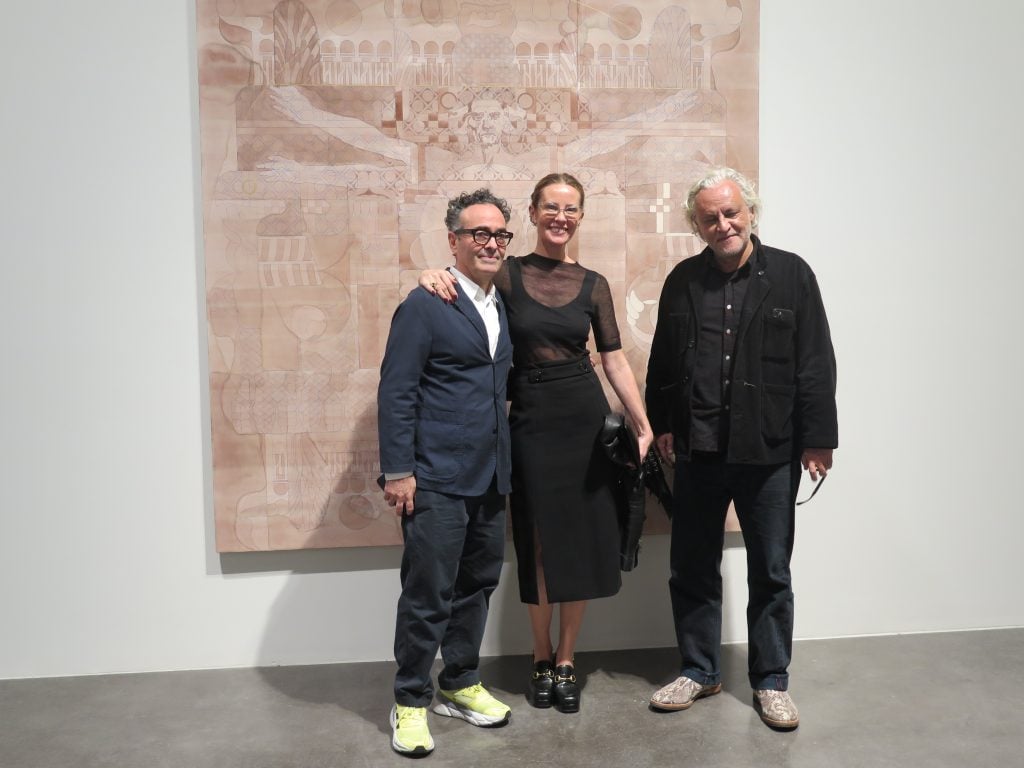
Gabriel Orozco, José Kuri and Mónica Manzutto at the opening of “Gabriel Orozco: Diarios de Plantas,” at kurimanzutto, Mexico City, 2024.
Mexico is a country that often does not feel its own. Coastal land that was held in common trust after the revolution is gone, bought and paved over to make way for American-owned resorts, and one hears English as much as Spanish in Mexico City neighborhood’s like Roma. There’s about a million slang words that address whiteness and foreignness, from “agringado” to “whitexican,” a mark of a culture wrestling to articulate racial, political, and class categories complicated by a fraught relationship with America.
For the gallerists, the founding of the New York space felt like a reversal of the usual power structure. Mexico City wasn’t the outpost, New York was. Orozco had a slightly different take.
“I have the feeling that there is no center in terms of aesthetics, ideology, politics. Of course, there is a big market in New York, in the US, but there is not a center anymore in the same way as before,” Orozco said. “I think you have more than one center, or maybe the center moves. Maybe this week, Mexico is the center of the world. And that’s it. And then the center will move, it will be somewhere else.”
Adjusting to this decentralized world is a challenge, but it’s one that Manzutto embraces. “Every stage has given me a certain kind of freedom,” she said. “The freedom we had when we had no space and no kids was very specific. Every step, every decision, and every artist has allowed us to feel some sort of freedom. But it is a constant question. How do you want to exist in this landscape that is constantly evolving?”
There’s no answer. Only the voracious search that keeps them moving forward.





